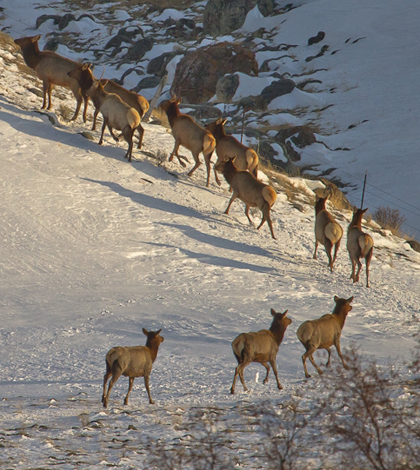Study hones in on Yellowstone’s disappearing migratory elk calves

Elk traveling on winter range in the northwestern Greater Yellowstone Ecosystem (Credit: Jonny Armstrong , Wyoming Cooperative Wildlife Research Unit/Univ. of Wyoming)
For the past 20 years, the thousands of elk that migrate into Yellowstone National Park each spring have left in the fall with fewer and fewer calves. An analysis of long-term climate data and an intensive three-year study of GPS-collared animals is helping tease out the relative effects of drought, grizzlies and wolves on the elks’ reproductive slump.
Up to 20,000 elk migrate from Yellowstone’s edges and spend the summer in the park, according to the U.S. National Park Service. The strategy gives the migrators access to additional food sources over the nonmigratory populations, said Arthur Middleton, who led the study while a doctoral student at the University of Wyoming.
“Each spring, they follow the green grass behind the melting snow up into their summer ranges, which are mostly inside Yellowstone National Park,” said Middleton, now a postdoctoral associate in the Yale School of Forestry and Environmental Studies. The tender emergent grass is easier to digest and has more nutrients. Migration is also thought to help the elk avoid predators, which tend to stick close to their den sites near the home ranges.
Not all elk migrate, but those that do are more abundant than their resident counterparts, which suggests that it’s been a historically successful strategy, Middleton said. But the migrators are returning from the park with half as many calves as they did 20 years ago. In the mid-1990s there were 30 to 40 calves per 100 cows in the Clarks Fork herd, a group of around 4,000 that Middleton studied. Now the herd is down to 10 to 15 calves per 100 cows.
In an effort to better understand what’s limiting reproduction in the migratory portion of the herd, Middleton and collaborators from state and federal agencies embarked on a study of climate data and the abundance of predatory grizzlies and wolves in the area. The researchers also used GPS collars to track the movements of around 100 elk and several wolves from packs that hunt the herd. They recaptured many collared elk twice a year and used ultrasound-based methods to analyze the animals’ body fat and check for pregnancy.

The researchers recaptured collard elk, analyzing nutrition and checking for pregnancy (Credit: Arthur Middleton)
The climate data show that warmer temperatures have sped up the spring green-up period, cutting the time that the elk have access to nutritious emergent grass. Drought conditions in the region have also degraded habitat. Meanwhile, the grizzly population has rebounded in the park, and the bears have emerged as the primary predator of elk calves.
“We know that grizzly bears have increased by more than threefold in numbers in the summer range of our migratory elk,” Middleton said. “What that added up to was fewer elk being born due to basically drought effects and forage quality on their summer range. Of those calves that did come into the world, they had much higher predation rates, particularly by bears that were removing calves soon after their birth in June.”
Though the increase in bear numbers is the main contributor to the grizzlies’ growing elk predation, Middleton’s study found that the invasion of lake trout in Yellowstone Lake may have also played a role. Lake trout, a non-native species discovered in the lake in 1994, have taken a toll on the lake’s population of native cutthroat trout. Cutthroat are an important food source to predators in the park, and lake trout are no substitute.
“Cutthroat trout used to spawn heavily in these really shallow tributary streams to Yellowstone Lake and were readily available to predators like bears that would scoop them up and feed on them,” Middleton said. “Lake trout spawn down in the depths of the lake, so they’re not an ecological replacement for cutthroat trout.”

Yellowstone’s grizzlies have become an important predator of elk calves (Credit: Bruce H Oakley, Courtesy University of Wyoming)
Bears are increasingly seeking out elk calves as an alternative meal, he said. Though the growing bear population is a bigger factor than the lake trout invasion, Middleton said its contribution is striking because it was brought on by people in the core of the Yellowstone system but has consequences for animals dozens of miles away.
“Because of migration, we can be observing some of the effects of that lake trout invasion when we look at elk that are 20 or 30 or 60 miles away from the lake in their winter ranges,” he said.
The researchers used data from the GPS-collared animals to try to figure out whether wolves are affecting elk beyond the individuals that they hunt and kill. For example, some biologists have suspected that elk that spend time avoiding and looking out for wolves may do so to the detriment of their health.
The collars logged location for collared animals every three hours. Between the GPS data and field observations, Middleton said they found that behavioral responses of elk to wolves were just too small and too infrequent to seem to accumulate in a way that impacted their fat or their pregnancy.
“You turn on National Geographic or the Discover Channel and you watch lots of predators chasing and eating lots of prey, and so we think that that’s happening all the time,” he said. “But how long did the photographer have to sit there and wait for that to capture that moment?”
Top image: Elk traveling on winter range in the northwestern Greater Yellowstone Ecosystem (Credit: Jonny Armstrong , Wyoming Cooperative Wildlife Research Unit/Univ. of Wyoming)




Dan
October 6, 2019 at 10:04 pm
I’ll sum it up in one word for you: WOLVES